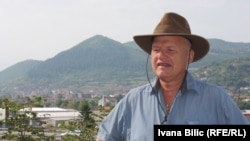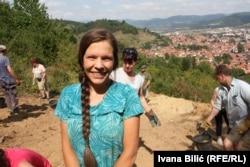Nedzad Secerovic doesn't know if he really believes it or not. He doesn't care either. Just as long as the crowds keep snapping up the kitschy souvenir pyramids he sells.
Like Nedzad, many in the town of Visoko, in Bosnia-Herzegovina, about a 30-minute drive north of Sarajevo, are benefitting from a tourist boom sparked by the disputed discovery of what, if proven, would be the world's largest set of pyramids and underground tunnels -- even if they currently look like huge, spiked hills overgrown with foliage and layers of dirt piled high over tens of thousands of years.
At the center of attention is a decade-old claim by a once-obscure archaeologist that he had found several large pyramids disguised as pointy peaks around the former medieval capital of Bosnia.
Semir Osmanagic has since sparked a cottage industry in what he believes are 30,000 year-old structures that dwarf the pharaohs' pyramids in Egypt, even while some of the world's most prominent archaeologists have called it a pyramid-sized hoax.
"In the beginning, 90 percent of the people were against the project. But now we can say it's about 50-50," says Secerovic, who has been making what he calls a "proper living" from selling souvenirs at his stall for the past 11 years. "We used to laugh at Osmanagic, we thought he was crazy. Now we're treating him with more and more respect."
When he first went to government officials with his findings, Osmanagic's claims drew excitement.
The eyes of the world focused on the possibility that an area already seen as the cradle of the Balkans may have been even more advanced than the civilization that built Egypt's famed pyramids. Soon afterward, state funds and tourists flowed into Osmanagic's Pyramid of the Sun Foundation and, in turn, Visoko, boosting the economy of the town's 11,000 residents.
What they found were several hills -- Osmanagic claims there are three main pyramids in the area -- including the Bosnian Pyramid of the Sun, which has a shape that most closely resembles a pyramid and is aligned almost perfectly with the Northern Star, a trait common with other pyramids around the world.
"I immediately knew from the base of those two elements -- geometry and perfect orientation – that this was not a natural hill, but an artificial structure. And after thousands of years, wind, and water, and rain, the pyramids had been covered," the frenetic 57-year-old, dubbed the Bosnian Indiana Jones, says as he takes a group of tourists and volunteer diggers on a tour of the area.
Initial digging and testing, he says, proves his theory. Blocks found among seven different excavation sites were found to be consistent with what Osmanagic says is concrete with a higher quality than what can be found at present-day building sites.
Scientific Skepticism
Osmanagic's extraordinary claims were not, however, widely accepted.
Archaeologists and historians from across the globe saw Osmanagic as little more than a huckster, peddling a "cruel hoax."
The European Association of Archaeologists has said the Bosnian pyramid theory is not based on genuine science and has repeatedly criticized Osmanagic's work since.
Carl Fegan, an American archaeologist who doubts the authenticity of the pyramids, admits that real archaeological sites exist within the hills, and says genuine artifacts and features are to be found from historical times, back through the medieval Roman period, and perhaps even as far back as the Neolithic Age or before.
"It may even be that the examples of writing found as inscriptions mentioned above are genuine. But without contexts and the careful, meticulous documentation that comes with a genuine archaeological project, they are meaningless," Fegan says.
"Osmanagic has created an air of theater and spurious significance around him, which immediately casts all that he does and finds in doubt. Quite simply, it cannot be trusted to be true," he adds.
Osmanagic knows the criticism and shrugs it off.
He questions their motivations to knock down a project that now uses private money and its own equipment, and he has a plan to prove he's right.
"We claim there is a structure, there is construction below the soil. The only way to find out is to dig! We have no problem. What was their problem? Why would somebody worry about digging in the remote Bosnian hills if there is nothing there?" he asks.
He adds: "This discovery changes forever what they teach us in schools about human history. Now we need to change our history books. It's a huge change. All the Ph.Ds, all the professorships, the way they teach our kids is wrong. And now we can understand the resistance in the cultural establishment against this project."
Maria Sofie knows what it's like to believe in something even when few others do.
It's her third visit to the site working as a volunteer to help excavate the area. For two months she'll enjoy her time digging and being with others who expect they are unveiling history.
"In my town, when I talk about the pyramids they look at me like an alien. So here, we are all aliens and we can all talk about this together," she says.
'Mystical Experience'
Still, the flow of money, no matter what the reason, couldn't have come at a better time for the region.
The Bosnian conflict inflicted heavy damage on the area. In addition to the human cost – in which thousands of lives were lost -- authorities estimate the Visoko region suffered about $200 million in damage with the destruction of infrastructure and factories.
Fegan says Osmanagic "appealed readily" to a nationalist need to have something to be proud of at a time when Visoko and Bosnia were economically and socially vulnerable.
Finally, attention on Visoko was not focused on bombs, bodies, and war. Instead, the world was looking "at the one commodity Bosnians could already be proud of: its beautiful countryside."
That may be true, but Albert Coruna says he came to visit from his home in Mexico to see more than some pretty hills.
An architect with a penchant for what he calls "alternative history," the 28-year-old unabashedly proclaims his love of digging as a motivating factor in making the 6,500-mile pilgrimage east to spend two weeks as part of a volunteer excavation crew at the site.
He says he has experienced the "energy flows" that some pyramids are noted for, and that "every day there is a mystical experience here."
For Secerovic, a former tailor who gave up his job to sell the pyramid souvenirs and other trinkets, that's more than enough for now.
He enjoys meeting tourists from around the globe and believes they won't stop coming "under any circumstance."
"You see the mass of tourists arriving from all over the world. People are asking for things, and you have to take advantage of the opportunity," he says.










